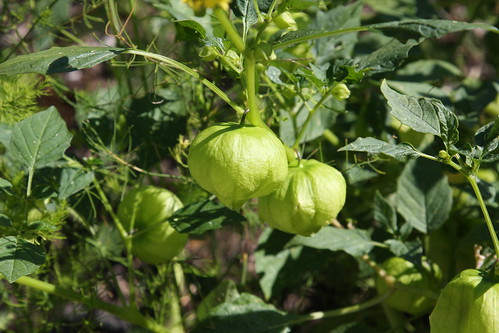Cropedia:Tomatillos
Tomatillos
" "
"
Source: http://www.flickr.com/photos/11133146@N03/4017314574/
Scientific name: Physalis philadelphica [4]
Tomatillos have fruits that are similar to the unripe tomato, but enclosed in a husk. Ripeness is indicated by a yellow colour, but tomatillos are most often used when still green. [5]
Tomatillos belong to the same family as the tomato, with an enhanced citrus aroma compared to the tomato. [5]
Tomatillos have been popular in Mexico and Latin America for a long time. [5] Tomatillos are most commonly used as a flavour enhancement to dishes and to stimulate appetite. They are also a favourite ingredient to include in salsas. [4]
Years grown at UBC Farm/LFSOG: about 10 years, on/off
Growing conditions
Raised like the tomato, but easier to grow than the tomato, tomatillos need no protection from rain, and grow well at warm temperatures. [6]
The growing conditions for tomatillos are listed below:
- Soil: Moderately fertile soil is required. [6]
- Sunlight: Full sun exposure is needed. [6]
- Water: Regular watering will ensure that plants continually produce fruit. [6]
- Planting: Have plants spaced approximately 1.0-1.2 metres (3-4') apart as the plant spreads. [6]
- Harvest: Length of harvest may last up to 2 months as fruits on the plant ripens unevenly. [2] For tomatillos used in salsa verde, harvest tomatillos while they are still green and their colour is just starting to lighten up toward the end near the blossom. For fresh eating, tomatillos are sweetest in flavour when they have turned yellow and the husk splits. [6]
Seasonality
Tomatillos grow best in the warm season, which includes mid-spring, late spring, early summer, and mid-summer. [6]
Nutritional Information
| Nutrition Facts/Valeur Nutritive | |
|---|---|
| Serving Size: 34g (1 medium raw) | |
| Amount Per Serving | %Daily Value* |
| Calories 11 | |
| Total Fat 0g | 0% |
| Saturated Fat 0g | 0% |
| Trans Fat 0g | |
| Cholesterol 0mg | 0% |
| Sodium 0mg | % |
| Total Carbohydrate 2g | 1% |
| Dietary Fiber 1g | 4% |
| Sugars 14g | |
| Protein 300mg | |
| Vitamine A | 0% |
| Vitamine C | 8% |
| Calcium | 0% |
| Iron | 1% |
| * % Daily value based on a 2000 calorie diet | |
Information based on Canadian Nutrient File [1][3]
Recipes
Recipes and other culinary uses of tomatillos can be found listed here:
Green Salsa by The Canadian Living Test Kitchen
Ingredients
- 1/3cup cup(75 mL) chopped drained canned tomatillos
- 1 seeded and minced jalapeño pepper
- 2 tablespoons ( 25 mL) minced green onion, white part only
- 4 teaspoons (18 mL) chopped fresh coriander or fresh parsley
- 2 teaspoons (10 mL) lime juice
- 1 pinch of granulated sugar
- 1 pinch of salt
Mix in large bowl and enjoy.
Ingredients
- 1½ cup tomatillos
- 1½ cup onion, chopped
- 2 garlic gloves, diced
- 1 tsp margarine
- 3¾ cup whole kernel corn
- 1 cup frozen peas
- 4 cups low sodium chicken broth
- 1 Tbsp cilantro, chopped
- 4 oz diced green chilies
- ¼ cup spinach, chopped
- 1 tsp sugar
Methods
- Sautè tomatillos, onion and garlic in with margarine for five minutes.
- Remove to food processor and add peas and cilantro. Puree to chunky.
- Pour in pan and add chicken stock, diced green chilies, chopped spinach, corn, and sugar.
- Heat and serve.
Additional usage inventory
Storage
- Fresh, non-peeled tomatillos can be stored for up to two weeks in the refrigerator, and are best stored inside paper bags. Fresh fruits without the husk last about 3 weeks under refrigeration in sealed plastic bags. Freezing the peeled tomatillos is another option. [5]
Selection
- Fresh tomatillos should have intact, tightly fit husks. The husk is light brown in colour. [5]
Other Uses
- An infusion of the husk could be added to tamale dough to improve the spongy-like consistency. Tomatillos could also be used to enhance the flavour of white rice and to tenderize red meats. [4]
Academic connections
Some research explores the potential of using tomatillos as natural health product to aid in cancer treatment.
References
- 1. Canadian Food Inspection Agency. (2010). Canadian food inspection agency. Retrieved from http://www.inspection.gc.ca/english/toce.shtml
- 2. Gough, B. (2008). Cherry, ground. In An encyclopedia of small fruit. Retrieved April 3 2010 from CRCnetbase: www.crcnetbase.com
- 3. Health Canada. (2010). Nutrient data. Retrieved from http://www.hc-sc.gc.ca/fn-an/nutrition/fiche-nutri-data/index-eng.php
- 4. Hernandez Bermejo, J.E. & Leon, J. (1994). Tomatillo, husk-tomato. In S. Montes Hernandez & J.R Aguirre Rivera (Ed.), Neglected crops: 1492 from a different perspective (p. 117-122). Retrieved from http://www.hort.purdue.edu/newcrop/1492/tomatillo.html
- 5. Fruits & Veggies Matter. (2010). Vegetable of the month: tomatillos. Retrieved from http://www.fruitsandveggiesmatter.gov/month/tomatillo.html
- 6. West Coast Seeds. (2010). How to grow Tomatillos. Retrieved February 23 2010 from http://www.westcoastseeds.com/how-to-grow/Vegetable-Seeds/Tomatillos/